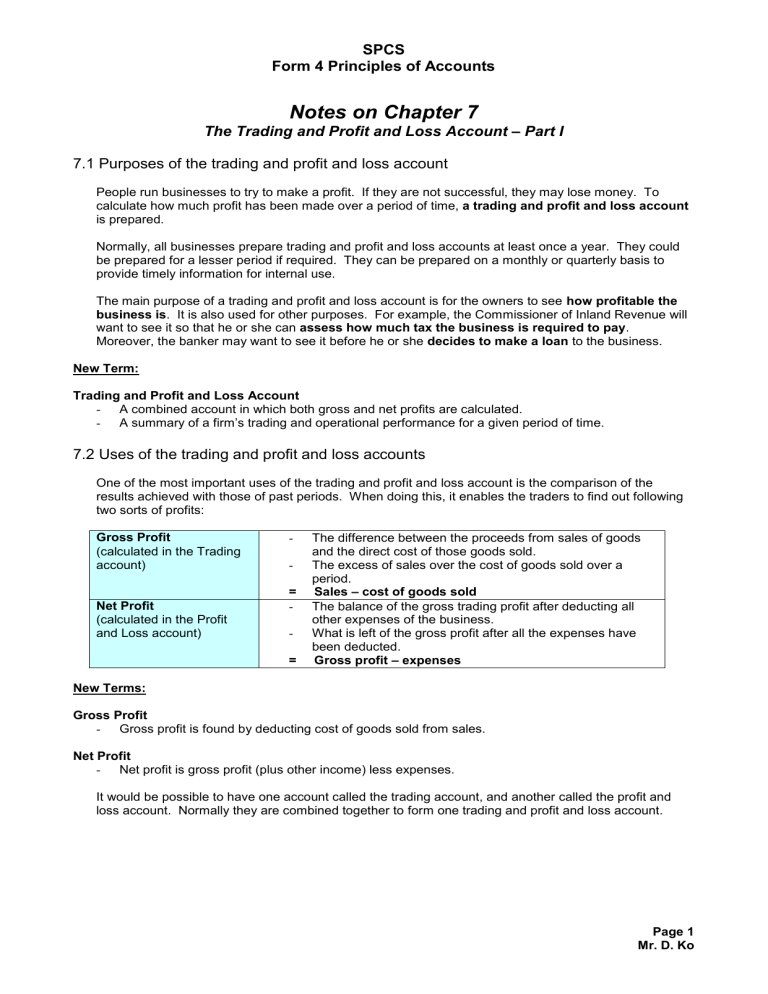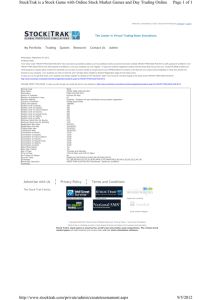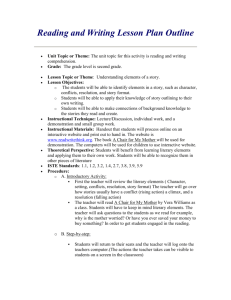The Trading and Profit and Loss Account

SPCS
Form 4 Principles of Accounts
Notes on Chapter 7
The Trading and Profit and Loss Account – Part I
7.1 Purposes of the trading and profit and loss account
People run businesses to try to make a profit. If they are not successful, they may lose money. To calculate how much profit has been made over a period of time, a trading and profit and loss account is prepared.
Normally, all businesses prepare trading and profit and loss accounts at least once a year. They could be prepared for a lesser period if required. They can be prepared on a monthly or quarterly basis to provide timely information for internal use.
The main purpose of a trading and profit and loss account is for the owners to see how profitable the business is . It is also used for other purposes. For example, the Commissioner of Inland Revenue will want to see it so that he or she can assess how much tax the business is required to pay .
Moreover, the banker may want to see it before he or she decides to make a loan to the business.
New Term:
Trading and Profit and Loss Account
A combined account in which both gross and net profits are calculated.
-
A summary of a firm’s trading and operational performance for a given period of time.
7.2 Uses of the trading and profit and loss accounts
One of the most important uses of the trading and profit and loss account is the comparison of the results achieved with those of past periods. When doing this, it enables the traders to find out following two sorts of profits:
Gross Profit
(calculated in the Trading account)
Net Profit
(calculated in the Profit and Loss account)
The difference between the proceeds from sales of goods and the direct cost of those goods sold.
The excess of sales over the cost of goods sold over a period.
= Sales – cost of goods sold
The balance of the gross trading profit after deducting all other expenses of the business.
What is left of the gross profit after all the expenses have been deducted.
= Gross profit – expenses
New Terms:
Gross Profit
Gross profit is found by deducting cost of goods sold from sales.
Net Profit
Net profit is gross profit (plus other income) less expenses.
It would be possible to have one account called the trading account, and another called the profit and loss account. Normally they are combined together to form one trading and profit and loss account.
Page 1
Mr. D. Ko
SPCS
Form 4 Principles of Accounts
7.3 Preparation of a trading and profit and loss account
Before drawing up a trading and profit and loss account, you should prepare a trial balance to see whether there are any arithmetic errors in the accounts. Adjusting entries will have to be made should there be any errors in the accounts.
In practice, a second trial balance is prepared after the adjustments to ensure that the accounts reflect a fairer view of income and expenditure for the period.
Assuming that there is no adjustment needed in the trial balance, the basic procedures in preparing a simple Trading and Profit and Loss account are as follows:
STEP 1 : Transfer the credit balance of the Sales account to the credit of the Trading account portion of the Trading and Profit and Loss account.
Debit:
Credit:
Sales account
Trading account
STEP 2 : Transfer the debit balance of the Purchases account to the debit side of the Trading account.
Debit:
Credit:
Trading account
Purchases account
Remember, in this case there is no stock of unsold goods. This means that:
Purchases = Cost of Goods Sold .
STEP 3 : If sales are greater than cost of goods sold, the difference is gross profit (If not, the answer would be a gross loss ). We will carry this gross profit figure from the Trading account part down to the profit and loss section. The double entry for gross profit is:
Debit:
Credit:
Trading account
Profit and loss account
Notice that after the Trading account has been completed, there are no balances remaining in the sales and purchases accounts. They are now closed.
STEP 4 : Transfer the debit balances on Expenses accounts to the debit of the Profits and Loss account.
Debit:
Credit:
Profit and loss account
Expenses accounts
STEP 5 : Transfer the net profit (if any), to the Capital account to show the increase in capital:
Debit:
Credit:
Profit and loss account
Capital account
7.4 Completion of capital account
You have seen that in STEP 5, we credit the capital account with the amount of net profit. We have therefore recorded the increase in capital.
In the trial balance, whenever there are drawings, they mean withdrawals of capital. After entering the net profit in the capital account, we can now complete the account. To do this, we transfer the drawings to the capital account. The double entry is:
Debit:
Credit:
Capital account
Drawings account
Page 2
Mr. D. Ko
SPCS
Form 4 Principles of Accounts
7.5 Example
Using the trial balance used below (in the Form Test), prepare the Trading and Profit and Loss account for
Mr. Wong for the month ended 30 June 2003.
Mr. Wong
Trial Balance as at 1 July 2003
Name of Accounts
Bank
Cash
Office Equipment
Purchases
Carriage Inwards
Rates
Mr. Yu
Gary
Returns Outwards
Insurance Premium
Sales
Carriage Outwards
Derek
Drawings
Capital
Amount
Debit (Dr)
$
114,250
8,350
4,000
9,800
300
225
1,100
350
1,600
5,025
Amount
Credit (Cr)
$
5,000
7,200
3,600
6,700
122,500
145,000 145,000
Page 3
Mr. D. Ko







